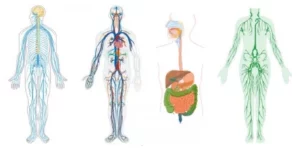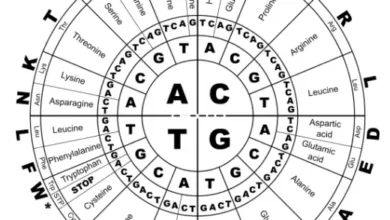The human nervous system: what it is, structure and functions

The nervous system is one of the systems of the human body , which is one of the levels of organization of matter . All of them are important, so establishing whether one is more important than another is complicated, however, it is extraordinarily complex both due to its structure and the sophisticated functions it performs, the operation of which is still very unknown today.
What is the nervous system?
The nervous system is made up of all the nervous tissue of the human body, and is the set of cells in charge of directing, supervising and controlling all functions and activities. of the organs and the body in general.
Although it is one of the smallest systems in the human body, its total weight does not reach 2 kg, its functions are among the most complex in the human body.
There are many different structures and forms of nervous systems depending on the animal group. The simplest is that of the cnidarians (polyps, jellyfish, siphonophores) which is a simple nerve network while that of the human being would be the most complex.
Only some animal groups do not have a nervous system such as, for example, porifers , placozoans and they do not have it and those that belong to the kingdom of protists such as protozoa or amoebas, do not have it because they are unicellular.
Parts of the human nervous system
The parts that compose it in human beings are the brain, the spinal cord and all the nerves that innervate the rest of the human body.
- The encephalon is located in the head and is made up of the brain, the medulla oblongata, the brainstem, and the cerebellum.
- The spinal cord is protected by the spinal column, and is the nerve cord that runs from the brainstem to the end of the spine.
- The rest of nerves in the human body are made up of long neurons that go from the spinal cord to the target site.
- The sense organs such as the eye or the ear and the nerves that interconnect them with the rest of the nervous system.
Neurons
Although it is not a proper part of this system, it is important to talk about neurons. They are highly specialized nerve cells that are the basic functional unit of the nervous system . Neurons are made up of three main parts: the soma (which is the largest part), the axon which is the elongated filament, and the synaptic endings at the end of the axon. The size of neurons can be from 0.1 mm to one meter depending on what they innervate, an example of longer neurons are the nerves that innervate muscles.
Along with neurons are Schwann cells, which are responsible for forming the myelin that covers the axon of neurons. This myelin sheath is essential for the proper functioning of neurons and its loss is the cause of diseases such as multiple sclerosis.
Classification of the nervous system
The nervous system can be classified differently depending on whether we pay attention to its functions or its anatomy.
Anatomical classification of the nervous system
The anatomical classification of the nervous system divides it into two types: the central nervous system and the peripheral nervous system.
Central nervous system (CNS)
It is anatomically composed of the brain and spinal cord where the control centers responsible for processing and integrating information are located. It is responsible for receiving sensitive information and processing it to program and coordinate responses to stimuli. You can have short-term control over other systems.
It is also the seat of higher functions such as memory, learning, intelligence and emotions.
Peripheral nervous system (PNS)
It is made up of all the nerves that are not part of the central nervous system but are connected to it . The peripheral nervous system provides the CNS with information from the sensory organs, conducts motor commands from the central nervous system to peripheral tissues and systems.
The SNP receives and issues information. The part of the SNP that receives and carries sensory information to the central nervous system is called the afferent division. The part that carries information from the CNS to the muscles and glands is called the efferent division.
Functional classification of the nervous system
When classified based on functions, it is divided into:
Somatic nervous system (SNS)
It is the part whose function is to control the voluntary or involuntary contraction. Control the striated muscle with voluntary actions such as walking and also involuntary actions such as removing a limb when we touch something very hot or quick reactions to stimuli that are painful or can be potentially painful.
Autonomic nervous system (ANS)
It is the nervous tissue that has the functions of controlling the contractions of the smooth muscle (involuntary contraction), the heart muscle and the glandular or visceral functions.
In turn, the ANS can be classified into two divisions :
Sympathetic Division or Sympathetic Nervous System
It is activated during emergency situations, stress or physical exercise. Regulates numerous actions involuntarily such as gland secretions. The most important neurotransmitters in this system are adrenaline and norepinephrine.
Parasympathetic division or parasympathetic nervous system
It predominates in resting conditions and its main activator is acetylcholine. When it comes into operation, the pulsations slow down, the gastrointestinal sphincters relax, intestinal peristalsis is stimulated …
In a generic way, their functions were simplified in such a way that it was pointed out that the sympathetic division is responsible for excitation and the parasympathetic one for inhibition, although this does not always have to be the case since it depends on whether the two divisions innervate the same structure or no, and how each process is controlled.
There are two other systems that are part of it:
- Limbic system that is made up of the nuclei and tracts along the boundary between the brain and the diencephalon. Hence its name, limbic comes from limit.
- Enteric nervous system which is the nervous system that enervates the intestine.
Nervous system function
The main function of the nervous system is to organize and respond to the human body to different external and internal stimuli and circumstances to ensure the correct adaptation and survival of the individual. Together with the endocrine system it controls and adjusts the activity of other systems.
Summary of nervous system functions
- Receive information from sensory receptors (sense organs).
- Relationship function through the coordination of several systems.
- Coordinates adaptation to external and internal circumstances to ensure the correct adaptation and survival of the individual. For example: responding to a sensory pain stimulus, organizing the fight / flight response, or perceiving phenomena such as rain or sun.
- Control and adjust the activity of other systems.
- It controls memory, learning, emotions, intelligence and language and speaks.
Sources:
Tortora , GJ, & Derrickson, B. (2010). PRINCIPLES OF ANATOMY AND PHYSIOLOGY (11th ed., 4th reprint). BUENOS AIRES: PAN AMERICAN DOCTOR
Frederic H. Martini , Michael J. Timmons, Robert B. Tallitsch. (2009). HUMAN ANATOMY (6th Edition). PEARSON EDUCACIÓN, SA, Madrid, 2009. ISBN: 978-84-7829-099-4.




